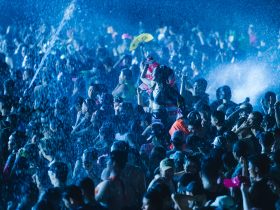Here are 8 reasons why you must visit Okinawa

1) The beaches and islands

Okinawa overlaps the sub-tropical and tropical zones and, with the hundreds of islands, it has some of the best and most underrated beaches in the world.
I’ve been to many beaches around the world. But the beaches and pristine waters off Okinawan islands are breathtaking. I would have never expected Japan to have beautiful beaches on par with the Maldives!
The locals don’t go to the beach much except for the occasional barbecue.
It could be the reason why it’s so pristine!
2) Their secret to longevity
Goya, or bitter gourd, is the favourite food of Okinawans. They have it on almost everything.
It is rich in vitamins, easy to grow, readily available, and serves as a staple in their diet. Which leads to their longevity! Or so we are told.
3) The longevity village
The Okinawans are renowned for their longevity. One of the areas worth visiting is the Longevity Village, with a large population of people in their 80s and 90s still working and playing!
Tours to the village usually include a sample meal that the locals eat.
4) Ryukyu Culture

The Ryukyu Kingdom stood for over 400 years. Much of its castles and cultural relics have been destroyed or pillaged during World War II.
Okinawa was the site of intense battle between Japan and the United States, where a third of the civilian population perished.
There is intense effort to restore many of the cultural icons including Shuri Castle, the palace of the last Ryukyu king. Many of the traditional wooden homes dating back hundreds of years have also been rescued, restored, and placed in cultural theme parks for tourists and locals.
5) Pose with 8.2M whale sharks

A modern day attraction is the Churaumi Aquarium. Sure, Singapore may have a larger aquarium but Churami Aquarium trumps them all with not one but three huge whale sharks!
Enormous and graceful, they swim peacefully with manta rays and other denizens of the local sea. It’s a rare sight indeed.
6) Must See! Must Buy! Ashibinaa Factory Outlet

Singapore is starved of good factory outlets. Sure, there’s one in Johor but Ashibinaa is in a different league. It has top name brands and the place is huge. It’s truly worth the visit.
If you’re shopping for premium branded goods, you’ll easily recoup the cost of travel to Okinawa from the savings alone! The tour package to Okinawa will usually include this place in the itinerary.
Shop fast and efficiently – there are many shops to cover in a short period.
7) Waterbirding

I’ve been told that there are only two places in the whole world for waterbirding, and one of them is Okinawa.
Basically, it’s shallow scuba diving. However, you’re sitting on a submersible pontoon anchored a kilometre from the shore. When the pontoon descends, you submerge with it.
You can feed the fish with breadcrumbs and the underwater guides will bring starfishes and sea cucumbers for you to touch. It’s fun and very safe, and anyone can do it.
8) Direct Charter flights make it easy
For many people, when it comes to visiting Japan, Okinawa seldom comes to mind. Part of the reason is flights.
For most of the year, Okinawa is only accessible via a stopover in other cities in Japan or in Taiwan.
For the next few months, however, there are direct charter flights from Singapore to Okinawa on SilkAir and Jetstar Asia. The flight duration is five hours, and it’s certainly more convenient than stopping over at somewhere else.
For first-timers, it’s probably easier to go with a package tour such as the “Okinawa Omotenashi Tour” offered by Dynasty Travel, where you’ll get to see the best of Okinawa in five days, and stay in very comfortable accommodations with private onsens, and fly on board SilkAir.
These are more than enough great reasons to visit Okinawa.
Experience a part of Japan that appears distinctively ‘un-Japanese’
The Okinawans, I’ve been told, are different from the mainland Japanese. They are shorter, darker and speak a different language. All this time, I thought Japan was culturally homogenous, and the Japanese are all cut from the same cloth.
I couldn’t have been more wrong.
Fascinating History
Believe it or not, when Sir Stamford Raffles landed in Singapore, Okinawa was an independent country known as the Ryukyu Kingdom. For 400 years, it had its own language, culture, kings, and way of life. But things change.
Slightly over 100 years ago, Japan, as part of its expansionist strategy, annexed the Ryukyu Kingdom, imposed imperial Japanese culture, and officially changed its name to Okinawa.
Birthplace of Karate
The Ryukyuans are a peaceful and proud lot. When the Japanese annexed the kingdom, there was very little resistance.
The Ryukyuans were not allowed to carry weapons, so they refined their “empty-hand” martial art, or karate, for self-defence – their greatest contribution to humanity.
Melting pot of Cultures
Okinawa, which means “rope in the open sea”, is the southernmost prefecture of Japan. It comprises hundreds of islands stretching from the main islands of Japan towards Taiwan. The island of Yunaguni, for instance, is slightly more than 100km from Taiwan.
For most of Ryukyu’s history, China was the greatest influence. No doubt, China meddled in its politics. Nonetheless, they had a very amicable, peaceful, and prosperous relationship with trade and cultural exchanges for hundreds of years. This accounts for the very strong Chinese cultural influences in Ryukyu culture.
The fascinating part is the mix of old Chinese culture with newer Japanese culture superimposed upon it.
Enter the Americans
As if it wasn’t complicated enough, after the surrender of Japan to the USA in World War II, Okinawa became a territory of the United States from 1952 to 1972. This was yet another layer of cultural influence upon the peaceful and (un)fortunate Ryukyuans.

By Frank Young
The author would like to thank Dynasty Travel for making this trip possible.
ADVERTISEMENTS










Leave a Reply